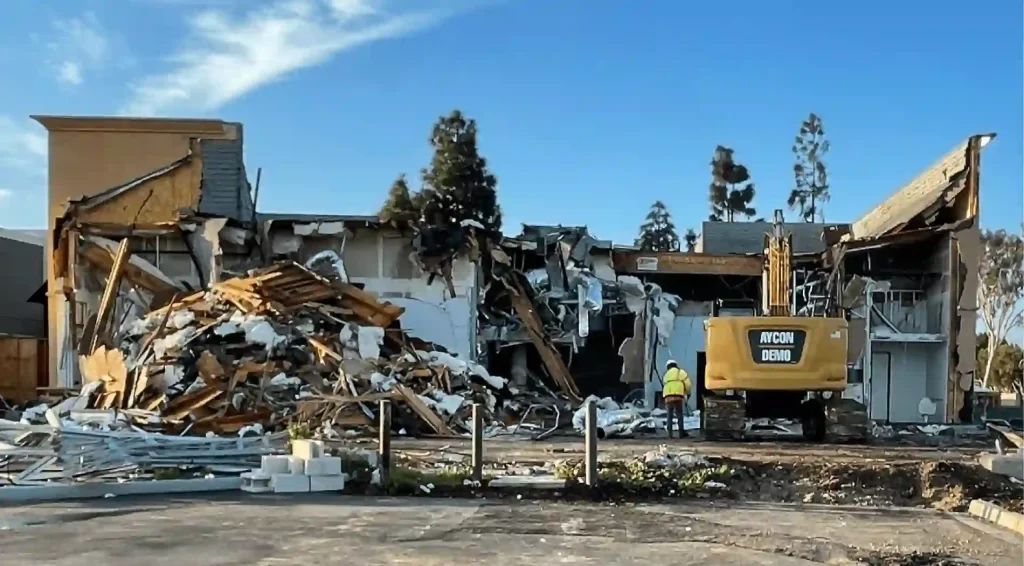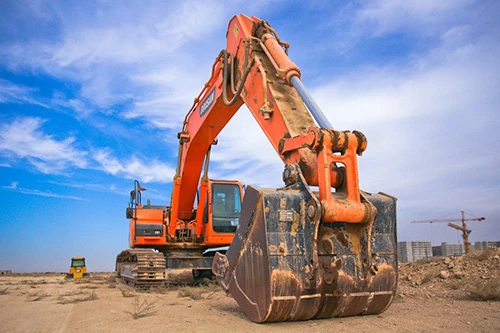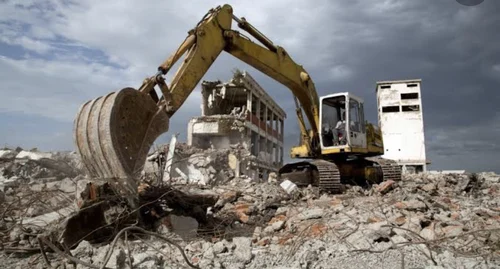Welcome to “Safety Measures in Commercial Demolition: A Comprehensive Guide.” Demolition, a crucial phase in construction and redevelopment, demands meticulous attention to safety to mitigate risks and ensure project success. This guide navigates the multifaceted realm of demolition safety, addressing regulatory compliance, risk assessment, equipment protocols, personnel training, and environmental considerations. From structural stability assessments to hazardous material handling procedures, each aspect is dissected to equip stakeholders with the knowledge and strategies necessary for safe demolition operations. By embracing these guidelines, demolition professionals can uphold safety standards, protect workers and the environment, and navigate the complexities of commercial demolition with confidence and efficiency. Navigating the dynamic landscape of commercial demolition requires a thorough understanding of safety measures to mitigate potential hazards and ensure a successful project outcome. This comprehensive guide delves into the intricacies of demolition safety, offering insights into regulatory compliance, risk management, equipment protocols, personnel training, and environmental considerations. From conducting structural stability assessments to implementing emergency response plans, each facet is meticulously explored to provide stakeholders with the knowledge and tools needed for safe and efficient demolition operations. By adhering to these guidelines, demolition professionals can prioritize the well-being of workers, protect the surrounding environment, and navigate the challenges of commercial demolition projects with confidence and proficiency.
Safeguarding Success: A Comprehensive Guide to Safety Measures in Commercial Demolition
Welcome to the definitive resource on ensuring safety in commercial demolition projects. Join A&B Junk Removal as we navigate the essential measures for a secure and successful demolition process.

Introduction to Commercial Demolition Safety:
Commercial demolition services involves the systematic dismantling or destruction of structures such as buildings, bridges, and industrial facilities. Safety is paramount in this process to protect both workers and the surrounding environment. The introduction to commercial demolition safety provides an overview of the importance of safety measures in demolition projects. It highlights the potential hazards involved, including structural instability, falling debris, exposure to hazardous materials, and equipment accidents. Emphasizing the need for a comprehensive approach to safety, the introduction sets the tone for the rest of the guide by underscoring the importance of adherence to regulations, rigorous risk assessment, proper training, and the implementation of safety protocols throughout the demolition process.
Understanding Regulatory Requirements and Compliance:
This section delves into the various regulations and standards that govern commercial demolition projects. It outlines the legal obligations and compliance requirements set forth by governmental agencies such as OSHA (Occupational Safety and Health Administration) and environmental protection agencies. The discussion includes a detailed examination of permits, licenses, and documentation necessary for initiating and carrying out demolition activities legally. Furthermore, it elucidates the consequences of non-compliance, including fines, penalties, and legal liabilities. By understanding and adhering to regulatory requirements, demolition contractors can ensure the safety of their workers, protect the surrounding community, and avoid potential legal repercussions.
Site Assessment and Risk Management in Commercial Demolition:
Before commencing any demolition project, a thorough site assessment is essential to identify potential hazards and develop appropriate risk management strategies. This section discusses the systematic approach to site assessment, which includes evaluating the structural integrity of the building, identifying hazardous materials such as asbestos, lead-based paint, or chemicals, and assessing environmental factors such as nearby utilities, traffic, and proximity to other structures. By conducting a comprehensive site assessment, demolition teams can proactively identify risks and implement effective mitigation measures to ensure the safety of workers and the surrounding area. Furthermore, the guide elaborates on risk management techniques, such as developing a risk register, creating contingency plans, and establishing communication protocols to address unforeseen challenges during the demolition process.
Equipment Safety Protocols: Tools, Machinery, and Heavy Equipment:
Commercial demolition often involves the use of a wide range of equipment, including excavators, bulldozers, cranes, and power tools. This section emphasizes the importance of maintaining equipment in proper working condition and implementing stringent safety protocols to prevent accidents and injuries. It discusses regular equipment inspections, maintenance schedules, and the use of personal protective equipment (PPE) such as hard hats, safety glasses, gloves, and ear protection. Additionally, the guide provides guidelines for safe operation of machinery, including proper training for equipment operators, adherence to manufacturer’s instructions, and the establishment of exclusion zones to prevent unauthorized personnel from entering hazardous areas. By prioritizing equipment safety, demolition contractors can minimize the risk of accidents and ensure a smooth and efficient demolition process.
Personnel Safety Training and Certification:
Ensuring that all personnel involved in commercial demolition projects receive adequate training and certification is crucial for maintaining a safe work environment. This section highlights the importance of providing comprehensive safety training programs tailored to the specific hazards and tasks encountered in demolition work. Training topics may include proper handling of hazardous materials, safe use of equipment and machinery, emergency procedures, and techniques for working at heights. Additionally, the guide stresses the significance of ongoing education and refresher courses to keep workers up-to-date with the latest safety protocols and industry best practices. Furthermore, the section emphasizes the necessity of obtaining relevant certifications and licenses for specific roles within the demolition team. This may include certifications for asbestos abatement, lead removal, and demolition operations. By ensuring that all personnel are properly trained and certified, demolition contractors can enhance safety awareness, reduce the likelihood of accidents and injuries, and demonstrate compliance with regulatory requirements. Additionally, investing in personnel safety training fosters a culture of safety within the organization, where employees prioritize their well-being and actively participate in maintaining a safe work environment.
Hazardous Material Handling and Disposal Procedures:
Commercial demolition projects often involve the handling and disposal of hazardous materials such as asbestos, lead-based paint, PCBs (polychlorinated biphenyls), and various chemicals. This section of the guide delves into the importance of implementing proper protocols for the identification, containment, removal, and disposal of hazardous materials. It emphasizes the necessity of conducting thorough surveys and assessments to identify the presence of hazardous materials before demolition activities commence. Once identified, hazardous materials must be handled with extreme care to prevent exposure to workers and the surrounding environment. The guide provides detailed guidance on the safe handling and removal of hazardous materials, including the use of specialized equipment, such as HEPA (high-efficiency particulate air) filters and negative air pressure enclosures, to minimize the spread of contaminants. It also discusses proper containment and disposal methods in compliance with regulatory requirements. This may include securing permits for transportation and disposal, utilizing licensed waste disposal facilities, and adhering to strict guidelines for packaging and labeling hazardous materials. By following established hazardous material handling and disposal procedures, demolition contractors can mitigate the risk of exposure, protect the health and safety of workers and the public, and minimize environmental impact.
Structural Stability Assessment and Pre-Demolition Precautions:
Before initiating any demolition activities, it’s essential to conduct a thorough structural stability assessment of the building or structure slated for demolition. This section of the guide emphasizes the importance of evaluating the integrity of the structure to identify potential weaknesses, such as structural damage, deterioration, or compromised load-bearing elements. Structural engineers or qualified professionals typically perform these assessments using a variety of methods, including visual inspections, structural analysis, and non-destructive testing techniques. Once potential risks are identified, appropriate precautions must be implemented to ensure the safe execution of demolition activities. This may involve reinforcing or shoring up unstable structures, installing temporary support systems, or employing controlled demolition techniques to mitigate the risk of unplanned collapses. Additionally, the guide outlines the importance of establishing exclusion zones and implementing perimeter fencing to restrict access to the demolition site and minimize the risk of injury to workers and the public. By prioritizing structural stability assessment and pre-demolition precautions, demolition contractors can effectively mitigate the risk of structural failure and ensure a safe demolition process from start to finish.
Emergency Preparedness and Response Plans:
Even with careful planning and adherence to safety protocols, emergencies can still occur during commercial demolition projects. This section of the guide emphasizes the importance of developing comprehensive emergency preparedness and response plans to effectively address unforeseen incidents and minimize potential harm. The guide outlines the key components of an emergency preparedness plan, including emergency contact information, evacuation procedures, and protocols for responding to accidents, injuries, fires, or hazardous material spills. Furthermore, the guide emphasizes the importance of conducting regular drills and training exercises to familiarize workers with emergency procedures and ensure a prompt and coordinated response in the event of an emergency. It also highlights the necessity of maintaining communication channels with local emergency services and agencies to facilitate rapid response and assistance if needed. By proactively preparing for emergencies and equipping workers with the knowledge and tools to respond effectively, demolition contractors can mitigate the impact of unexpected incidents and safeguard the well-being of workers and the surrounding community.
Environmental Protection and Conservation Measures:
Commercial demolition activities have the potential to impact the surrounding environment through dust, noise, and the release of hazardous materials. This section of the guide emphasizes the importance of implementing measures to minimize environmental impact and promote conservation efforts throughout the demolition process. It discusses strategies for controlling dust and airborne contaminants through the use of water sprays, dust suppression systems, and barriers to contain debris. Moreover, the guide addresses the proper disposal of construction and demolition waste to prevent pollution and minimize landfill usage. It highlights the importance of sorting and recycling materials whenever possible to reduce the environmental footprint of demolition projects. Additionally, the guide encourages the use of eco-friendly demolition techniques and materials, such as deconstruction instead of traditional demolition methods, to salvage reusable materials and minimize waste generation. By prioritizing environmental protection and conservation measures, demolition contractors can mitigate the ecological impact of their activities and contribute to sustainable development efforts. Implementing stringent measures for preventing and managing asbestos exposure in commercial demolition projects is vital, especially considering its relevance to chair removal and home accessibility concerns within Michigan’s aging population.

Post-Demolition Site Cleanup and Safety Inspection:
After completing the demolition activities, thorough site cleanup is essential to ensure the safety of the surrounding environment and prepare the area for future use or development. This section of the guide outlines the steps involved in post-demolition cleanup, including the removal of debris, demolition waste, and hazardous materials from the site. It emphasizes the importance of conducting a comprehensive inspection to identify any remaining hazards or potential risks, such as unstable debris, buried utilities, or contaminated soil. Furthermore, the guide discusses the necessity of properly disposing of demolition waste in accordance with regulatory requirements and environmental standards. This may involve sorting materials for recycling, salvaging reusable materials, and transporting non-recyclable waste to licensed disposal facilities. Additionally, the guide underscores the importance of conducting post-demolition safety inspections to verify that the site is safe for occupancy and complies with regulatory standards. By prioritizing post-demolition cleanup and safety inspections, demolition contractors can ensure that the site is left in a safe and environmentally responsible condition, minimizing risks to future occupants and the surrounding community.
FAQs
What safety training do workers need for commercial demolition?
Workers need comprehensive training in hazardous material handling, equipment operation, emergency response, and structural assessment to ensure safety during demolition projects.
How can hazardous materials be safely managed during demolition?
Hazardous materials should be identified, contained, and removed by trained professionals using proper equipment and disposal methods in compliance with regulatory requirements.
What precautions are taken to ensure structural stability during demolition?
Structural engineers conduct assessments to identify weaknesses, and precautions such as reinforcement, shoring, and controlled demolition techniques are implemented to mitigate the risk of structural failure.
What emergency preparedness measures are in place for demolition sites?
Emergency preparedness plans include evacuation procedures, emergency contact information, and regular training drills to ensure a prompt and coordinated response to accidents or incidents.
How is environmental impact minimized during commercial demolition?
Environmental impact is minimized through dust and noise control measures, proper waste disposal, recycling of materials, and the use of eco-friendly demolition techniques to promote sustainability.
Conclusion
In conclusion, the implementation of robust safety measures is paramount in commercial demolition projects to safeguard the well-being of workers, protect the surrounding environment, and ensure compliance with regulatory standards. This comprehensive guide has highlighted the importance of thorough site assessments, adherence to regulatory requirements, proper equipment safety protocols, personnel training, and hazardous material handling procedures. Additionally, emphasis has been placed on structural stability assessment, emergency preparedness, environmental protection, and post-demolition cleanup. By following these guidelines and prioritizing safety at every stage of the demolition process, demolition contractors can mitigate risks, minimize accidents, and contribute to the successful completion of demolition projects in a safe and responsible manner. In the ever-evolving landscape of commercial demolition, it’s crucial to uphold safety as a fundamental priority. Through the detailed exploration of safety measures outlined in this guide, a holistic approach to demolition projects emerges—one that encompasses regulatory compliance, risk assessment, personnel training, and environmental stewardship. Each facet of safety addressed underscores the complex interplay of factors at play in demolition endeavors, from the meticulous scrutiny of structural integrity to the meticulous handling of hazardous materials. By adhering to these guidelines and fostering a culture of safety consciousness, stakeholders in the demolition industry can not only mitigate potential hazards but also elevate standards of professionalism and responsibility, ensuring the sustainable progress of demolition practices into the future.




